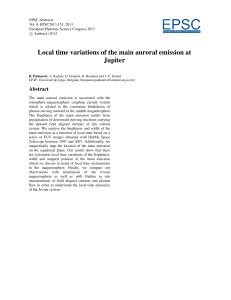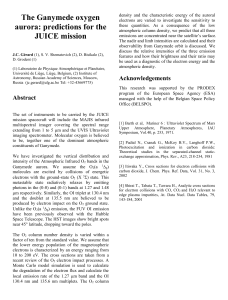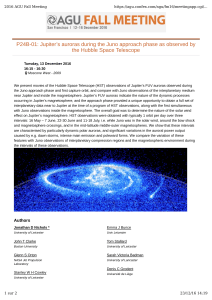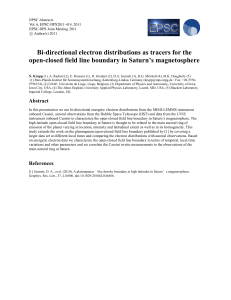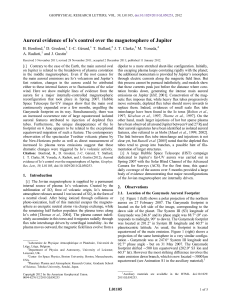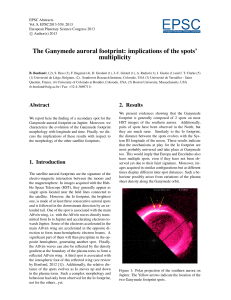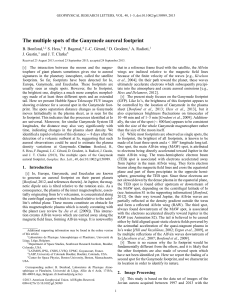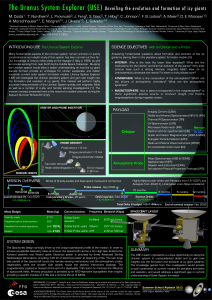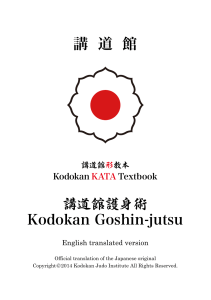Processes Shaping Galilean Satellite Atmospheres from the Surface
publicité
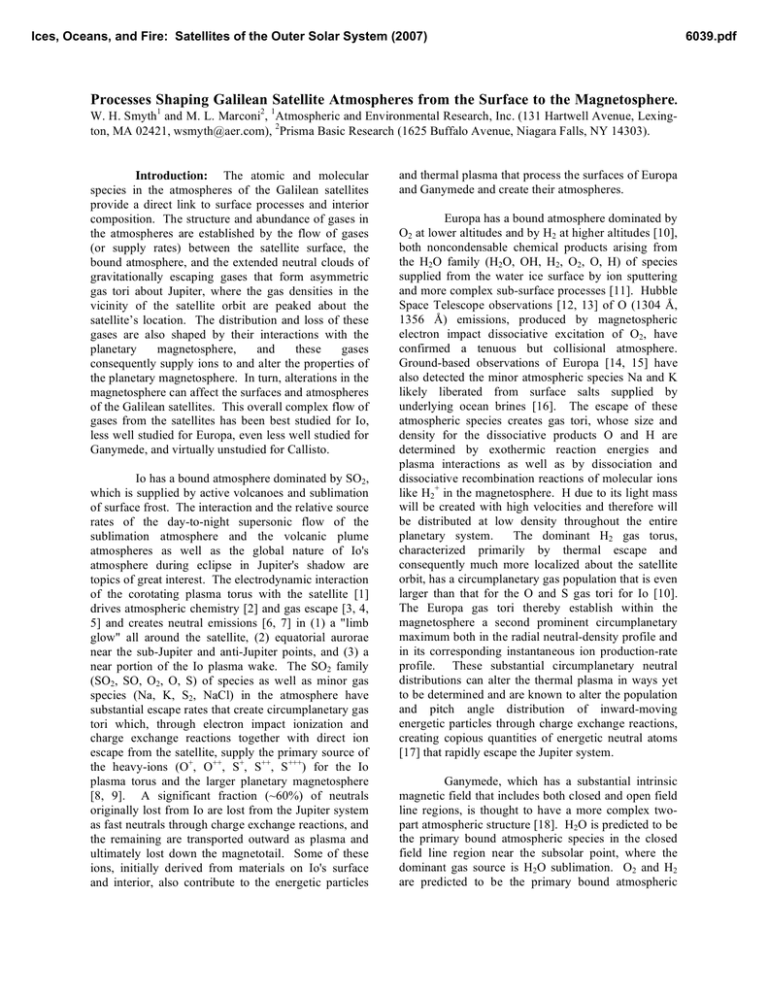
Ices, Oceans, and Fire: Satellites of the Outer Solar System (2007) Processes Shaping Galilean Satellite Atmospheres from the Surface to the Magnetosphere. W. H. Smyth1 and M. L. Marconi2, 1Atmospheric and Environmental Research, Inc. (131 Hartwell Avenue, Lexington, MA 02421, [email protected]), 2Prisma Basic Research (1625 Buffalo Avenue, Niagara Falls, NY 14303). Introduction: The atomic and molecular species in the atmospheres of the Galilean satellites provide a direct link to surface processes and interior composition. The structure and abundance of gases in the atmospheres are established by the flow of gases (or supply rates) between the satellite surface, the bound atmosphere, and the extended neutral clouds of gravitationally escaping gases that form asymmetric gas tori about Jupiter, where the gas densities in the vicinity of the satellite orbit are peaked about the satellite’s location. The distribution and loss of these gases are also shaped by their interactions with the planetary magnetosphere, and these gases consequently supply ions to and alter the properties of the planetary magnetosphere. In turn, alterations in the magnetosphere can affect the surfaces and atmospheres of the Galilean satellites. This overall complex flow of gases from the satellites has been best studied for Io, less well studied for Europa, even less well studied for Ganymede, and virtually unstudied for Callisto. Io has a bound atmosphere dominated by SO2, which is supplied by active volcanoes and sublimation of surface frost. The interaction and the relative source rates of the day-to-night supersonic flow of the sublimation atmosphere and the volcanic plume atmospheres as well as the global nature of Io's atmosphere during eclipse in Jupiter's shadow are topics of great interest. The electrodynamic interaction of the corotating plasma torus with the satellite [1] drives atmospheric chemistry [2] and gas escape [3, 4, 5] and creates neutral emissions [6, 7] in (1) a "limb glow" all around the satellite, (2) equatorial aurorae near the sub-Jupiter and anti-Jupiter points, and (3) a near portion of the Io plasma wake. The SO2 family (SO2, SO, O2, O, S) of species as well as minor gas species (Na, K, S2, NaCl) in the atmosphere have substantial escape rates that create circumplanetary gas tori which, through electron impact ionization and charge exchange reactions together with direct ion escape from the satellite, supply the primary source of the heavy-ions (O+, O++, S+, S++, S+++) for the Io plasma torus and the larger planetary magnetosphere [8, 9]. A significant fraction (~60%) of neutrals originally lost from Io are lost from the Jupiter system as fast neutrals through charge exchange reactions, and the remaining are transported outward as plasma and ultimately lost down the magnetotail. Some of these ions, initially derived from materials on Io's surface and interior, also contribute to the energetic particles and thermal plasma that process the surfaces of Europa and Ganymede and create their atmospheres. Europa has a bound atmosphere dominated by O2 at lower altitudes and by H2 at higher altitudes [10], both noncondensable chemical products arising from the H2O family (H2O, OH, H2, O2, O, H) of species supplied from the water ice surface by ion sputtering and more complex sub-surface processes [11]. Hubble Space Telescope observations [12, 13] of O (1304 Å, 1356 Å) emissions, produced by magnetospheric electron impact dissociative excitation of O2, have confirmed a tenuous but collisional atmosphere. Ground-based observations of Europa [14, 15] have also detected the minor atmospheric species Na and K likely liberated from surface salts supplied by underlying ocean brines [16]. The escape of these atmospheric species creates gas tori, whose size and density for the dissociative products O and H are determined by exothermic reaction energies and plasma interactions as well as by dissociation and dissociative recombination reactions of molecular ions like H2+ in the magnetosphere. H due to its light mass will be created with high velocities and therefore will be distributed at low density throughout the entire planetary system. The dominant H2 gas torus, characterized primarily by thermal escape and consequently much more localized about the satellite orbit, has a circumplanetary gas population that is even larger than that for the O and S gas tori for Io [10]. The Europa gas tori thereby establish within the magnetosphere a second prominent circumplanetary maximum both in the radial neutral-density profile and in its corresponding instantaneous ion production-rate profile. These substantial circumplanetary neutral distributions can alter the thermal plasma in ways yet to be determined and are known to alter the population and pitch angle distribution of inward-moving energetic particles through charge exchange reactions, creating copious quantities of energetic neutral atoms [17] that rapidly escape the Jupiter system. Ganymede, which has a substantial intrinsic magnetic field that includes both closed and open field line regions, is thought to have a more complex twopart atmospheric structure [18]. H2O is predicted to be the primary bound atmospheric species in the closed field line region near the subsolar point, where the dominant gas source is H2O sublimation. O2 and H2 are predicted to be the primary bound atmospheric 6039.pdf Ices, Oceans, and Fire: Satellites of the Outer Solar System (2007) species near the poles in the open field line regions, where magnetospheric ion sputtering is the dominant gas source, and are also predicted to be the primary bound atmospheric species within the nightside atmosphere. Hubble Space Telescope observations of O (1304 Å, 1356 Å) emissions [13, 19] have been interpreted as being produced by magnetospheric electron impact dissociation of O2 in a collisional but tenuous atmosphere. H, which is expected to be produced mainly from electron impact dissociation of H2, has also been detected with the Hubble Space Telescope [19] and the Galileo UV spectrometer [20] in an extended distribution from near the surface to several Ganymede radii via its scattering of solar Lyman-α photons. Pickup ions formed in the atmosphere can accumulate in the closed field line regions and escape more readily in the open field line regions, affecting the charge exchange loss of neutrals from the atmosphere and the detection of near-satellite ions, as is the case for Europa, through pickup ion signatures [21] and ion-cyclotron waves [22]. In addition, substantial gas escape rates are expected from dissociative products, mainly O and H, with exothermic reaction energies forming even more distant gas tori about the planet. The primary escaping species and also dominant species at higher altitudes is, however, H2. Like the H2 from Europa, the H2 from Ganymede escapes thermally and is also expected to form a torus but one that is more dispersed due to its larger distance from Jupiter. In summary, neutrals, ions, and their emissions along the flow of gases from the satellite surface, to the bound atmosphere, to the extended neutral clouds, and to the magnetosphere contain vital information that, through measurements and modeling, provides a powerful approach to connect and illuminate the physical processes that occur along this chain of events. References: [1] Saur J. et al. (1999) JGR, 104, 2510525126. [2] Smyth W. H. and Wong M. C. (2004) Icarus, 171, 171-182. [3] Smyth W. H. and Combi M. R. (1997) Icarus, 126, 58-77. [4] Smyth W. H. and Marconi M. L. (2000) JGR, 105, 7783-7792. [5] Wilson J. et al. (2002) Icarus, 157, 476-498. [6] Roesler F. L. et al. (1999) Science, 283, 353-357. [7] Retherford K. D. et al. (2000) JGR, 105, 27157-27165. [8] Smyth W. H. and Marconi M. L. (2003) Icarus, 166, 85-106. [9] Smyth W. H. and Marconi M. L. (2005) Icarus, 176, 138-154. [10] Smyth W. H. and Marconi M. L. (2006) Icarus, 181, 510-526. [11] Johnson R. E. and Quickenden T. I. (1997) JGR, 102, 10985-10996. [12] Hall D. T. et al. (1995) Nature, 373, 677-679. [13] Hall D. T. et al. (1998) Ap.J., 499, 475481. [14] Brown M.E. and Hill R.E. (1996) Nature, 380, 229-231. [15] Brown M. E. (2000) Icarus, 151, 190-195. [16] Leblanc F. et al. (2002) Icarus, 159, 132-144. [17] Mauk B. H. et al. (2003) Nature, 421, 920-922. [18] Marconi M. L. (2007) Icarus, in press. [19] Feldman P. D. et al. (2000) Ap. J., 535, 10851090. [20] Barth C. A. et al. (1997) GRL, 24, 21472150. [21] Paterson W. R. et al. (1999) JGR, 104, 22779-22792. [22] Volwerk M. et al. (2001) JGR, 106, 26033-26048. 6039.pdf
